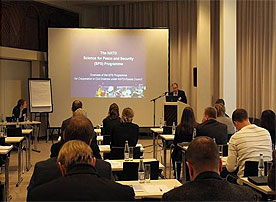NRC scientists cooperating to detect Baltic oil spills
Ensuring environmental security is a present-day challenge all NATO-Russia Council (NRC) nations are faced with. One NRC Science for Peace and Security (SPS) project in particular, is already tackling a significant environmental threat in the Baltic Sea, and in the process, taking on the ambitious task of becoming a leading region for environmental safety and security. The project aims to improve the detection of oil spills in the Baltic Sea, initially by researching and comparing existing technology for oil spill detection, and then in later phases of the project, by testing the best methods in the South-Eastern region of the Baltic.

The project for the “Development of solutions for effective oil spill management in South-Eastern Baltic” was mandated in the NRC’s Work Programme for 2013, and is jointly led by Klaipeda University’s Coastal research and planning institute in Lithuania, and the Atlantic Branch of Shirshov Institute of Oceanology at the Russian Academy of Sciences, with the support of the SPS Programme. It is a direct response to regional economic and environmental challenges in the Baltic.
Since the project’s official launch at a meeting in Russia on 7 August 2012, participating scientists have been working together researching innovative methods and solutions to detect oil spills, forecast their drift and dispersion, and identify the environmental features most vulnerable to accidental pollution in marine areas. Through their work, scientists are aiming to reduce the risks of oil spills and their possible impact on Baltic Sea ecosystems.
“There is a huge need to fill the knowledge gaps existing in the South-Eastern Baltic with regard to the detection of oil pollution, predicting oil spill trajectories and identifying most vulnerable marine habitats,” says Dr Gulbinskas, the director of the project, and Vice Director of Klaipeda University Coastal Research and Planning Institute in Lithuania.

For this reason the project holds particular relevance given the Baltic Sea’s vulnerability to oil spills, as one of the most intensely trafficked shipping areas in the world, with around 2000 ships in the Baltic marine area at any given moment. Both the number and the size of ships have grown in recent years. Along with general traffic the Baltic Sea is also actively used for the transportation of oil and other hazardous cargoes, which have the potential to cause devastating damage to fragile ecosystems. The project will help to reduce the risk of accidents and their possible impact on the environment, by planning appropriate actions for oil spill response in a long-term perspective.
NRC nations Russia and Lithuania are co-directing the project, and clearly share a common interest in mitigating the risks posed by potential oil spills in the region. Dr Sivkov, co-director of the project, and Director of Atlantic branch of P.P. Shirshov Institute of Oceanology underlined: “It is extremely important to strengthen scientific cooperation between Russia and Lithuania as these countries share the Curonian Spit, a particularly sensitive area protected by UNESCO.”
The implementation of cooperative research in this NRC SPS project will lead to the development of measures to prevent ecological disasters and the reduction of the risks they pose, in turn improving environmental security in the Baltic Sea region. This project again demonstrates how NRC cooperation can be effective in responding to a wide range of common challenges, in this instance from a significant environmental threat to the UNESCO protected South-Eastern region of the Baltic Sea.
The Science for Peace and Security Programme, or SPS, is a policy tool for enhancing cooperation and dialogue with all partners including the Russian Federation, based on civil science and innovation, to contribute to the Alliance’s core goals and to address the priority areas for dialogue and cooperation identified in the new partnership policy. More information can be found at www.nato.int/science/
